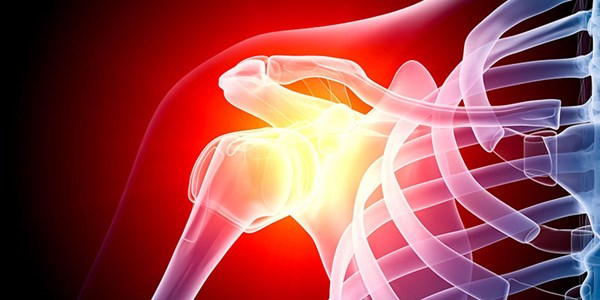In 2012, there were more than 16,000 ED visits for septic arthritis in the United States; this accounted for approximately 0.01% of all ED visits.1
Although septic arthritis is a relatively infrequent diagnosis made in the ED, a poor outcome is seen in almost half of patients depending on age and comorbidities.2 While Methicillin-resistant Staphylococcus aureus (MRSA) is a well-known and feared cause of septic arthritis, P. aeruginosa needs to be considered by the emergency physician when caring for an IV drug user.3,4 We present a case of septic arthritis in the shoulder caused by P. aeruginosa.
Case
A 40-year-old female presented to the ED with a complaint of fevers and left shoulder pain. She had a past medical history of hypothyroidism and IV drug use. She reported that over the last three days she was having worsening shoulder pain with associated fever/chills. She denied any recent trauma. She stated the shoulder pain radiates to her left chest and into her back. Upon further questioning she did admit to using heroin daily. Interestingly, she stated several days prior to the pain starting she had attempted to inject heroin in her left forearm but reported the vein blew and therefore did not inject.
She denied any pain like this in the past and denied ever injecting anything into her shoulder. She had no history of significant bacterial illness. She had no cardiac history (EKG and troponin were subsequently normal). Review of systems was negative for any neurologic, respiratory, or GI complaints.
On exam she was found to be febrile to 100.4 C, and her heart rate was 110 bpm. She had extensive pain with passive range of motion of the left shoulder, but the shoulder was without erythema, warmth, or joint swelling. X-ray was negative for any acute abnormality. However, there was still concern for septic arthritis given her history of IV drug use, so the patient was consented for arthrocentesis. Using a curved linear ultrasound probe, a posterior approach arthrocentesis was performed. A joint effusion was present between the glenoid fossa and humeral head.
The landmarks were marked and the patient was prepped and draped in usual sterile fashion. The needle was inserted just below the scapular spine. Five milliliters of cloudy fluid was obtained. Synovial fluid studies showed 67,740 cells/mm3) with 95% neutrophils. Gram stain was negative. Other lab workup subsequently showed a CRP of 4.1, ESR of 54, and WBC count of 12.2.
Orthopedics was consulted, and the patient was admitted to the hospital. Based on established recommendations, Vancomycin and Ceftriaxone were given empirically.10,11 Blood cultures were negative. The patient underwent washout the next morning. Less than 24 hours later the synovial fluid grew P. aeruginosa and ceftriaxone was then changed to cefepime.
The patient stayed an additional day, but unfortunately left against medical advice with a prescription for 6 weeks of ciprofloxacin.
Discussion
Many patients present to the ED with musculoskeletal complaints; however, septic arthritis is a relatively uncommon diagnosis (7.8 cases per 100,000 person-years).5 The shoulder only accounts for 5-12% of cases of septic arthritis.6 The most frequent organism encountered in the general population as well as IV drug users is Staphylococcus aureus.7,9 Septic arthritis in IV heroin users is frequently caused by MRSA and less commonly P. aeruginosa, with a recent large study showing it causes less than 2% of cases.8,9 When P. aeruginosa septic arthritis is diagnosed, it is typically seen affecting the sternoclavicular, hip or sacroiliac joints, with one study not reporting any cases of P. aeruginosa in the shoulder.8 Commonly, vancomycin and ceftriaxone are recommended for initial empiric treatment of presumed septic arthritis in the ED as they cover the vast majority of the pathogens.10,11 Due to the significant morbidity associated with septic arthritis it is important for the emergency physician to consider P. aeruginosa as the cause of joint pain in the IV drug user.
Conclusion
Although relatively uncommon, septic arthritis is a “can’t-miss” diagnosis. Timely diagnosis and treatment is imperative due to the high morbidity associated with it. While P. aeruginosa does not frequently cause septic arthritis, a thorough history is paramount and physicians should consider antipseudomonal coverage with any history of IV drug use.
References
- Singh JA, Yu S. Septic Arthritis in Emergency Departments in the US: A National Study of Health Care Utilization and Time Trends. Arthritis Care Res (Hoboken). 2018;70(2):320-326. doi:10.1002/acr.23270
- Kaandorp, C. J., Krijnen, P., Moens, H. J., Habbema, J. D., & van Schaardenburg, D. (1997). The outcome of bacterial arthritis: a prospective community-based study. Arthritis and rheumatism, 40(5), 884–892. https://doi.org/10.1002/art.1780400516
- Allison DC, Holtom PD, Patzakis MJ, Zalavras CG. Microbiology of bone and joint infections in injecting drug abusers. Clin Orthop Relat Res. 2010;468(8):2107-2112. doi:10.1007/s11999-010-1271-2
- Ross JJ. Septic Arthritis of Native Joints. Infect Dis Clin North Am. 2017;31(2):203-218. doi:10.1016/j.idc.2017.01.001
- Roerdink RL, Huijbregts HJTAM, van Lieshout AWT, Dietvorst M, van der Zwaard BC. The difference between native septic arthritis and prosthetic joint infections: A review of literature. J Orthop Surg (Hong Kong). 2019 May-Aug. 27 (2):2309499019860468
- Jiang, Jimmy, Piponov, Hristo, Mass, Daniel, Angeles, Jovito, Shi, Lewis. Septic Arthritis of the Shoulder: A Comparison of Treatment Methods. J Am Acad Orthop Surg. 2017;25(8):e175-e184. doi:10.5435/JAAOS-D-16-00103.
- Goldenberg D.L.: Septic arthritis. Lancet 1998; 351: pp. 197-202.
- 1. Brancós M, Peris P, Miró J et al. Septic arthritis in heroin addicts. Semin Arthritis Rheum. 1991;21(2):81-87. doi:10.1016/0049-0172(91)90041-w
- Ross JJ, Ard KL, Carlile N. Septic Arthritis and the Opioid Epidemic: 1465 Cases of Culture-Positive Native Joint Septic Arthritis From 1990-2018. Open Forum Infect Dis. 2020;7(3):ofaa089. Published 2020 Mar 12. doi:10.1093/ofid/ofaa089
- Cameron P, Little M, Mitra B, Deasy C, Carman C. Septic Arthritis. In: Textbook of Adult Emergency Medicine. Edinburgh: Elsevier; 2020:400-402.
- Marx JA, Hockberger RS, Walls RM. Chapter 136: Bone and Joint Infections . In: Rosen's Emergency Medicine: Concepts and Clinical Practice (2 Volumes). Philadelphia, Pennsylvania: Elsevier Saunders; 2014.



